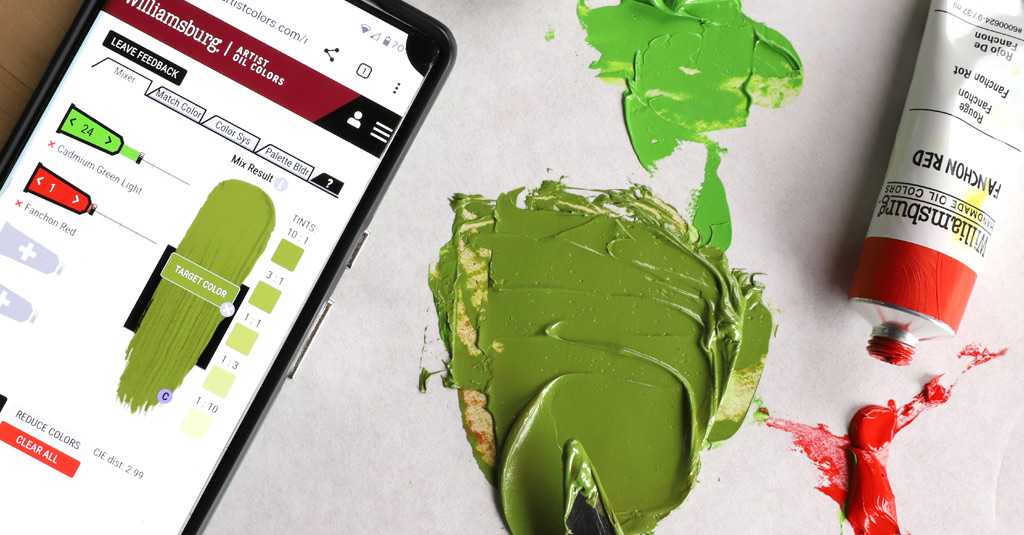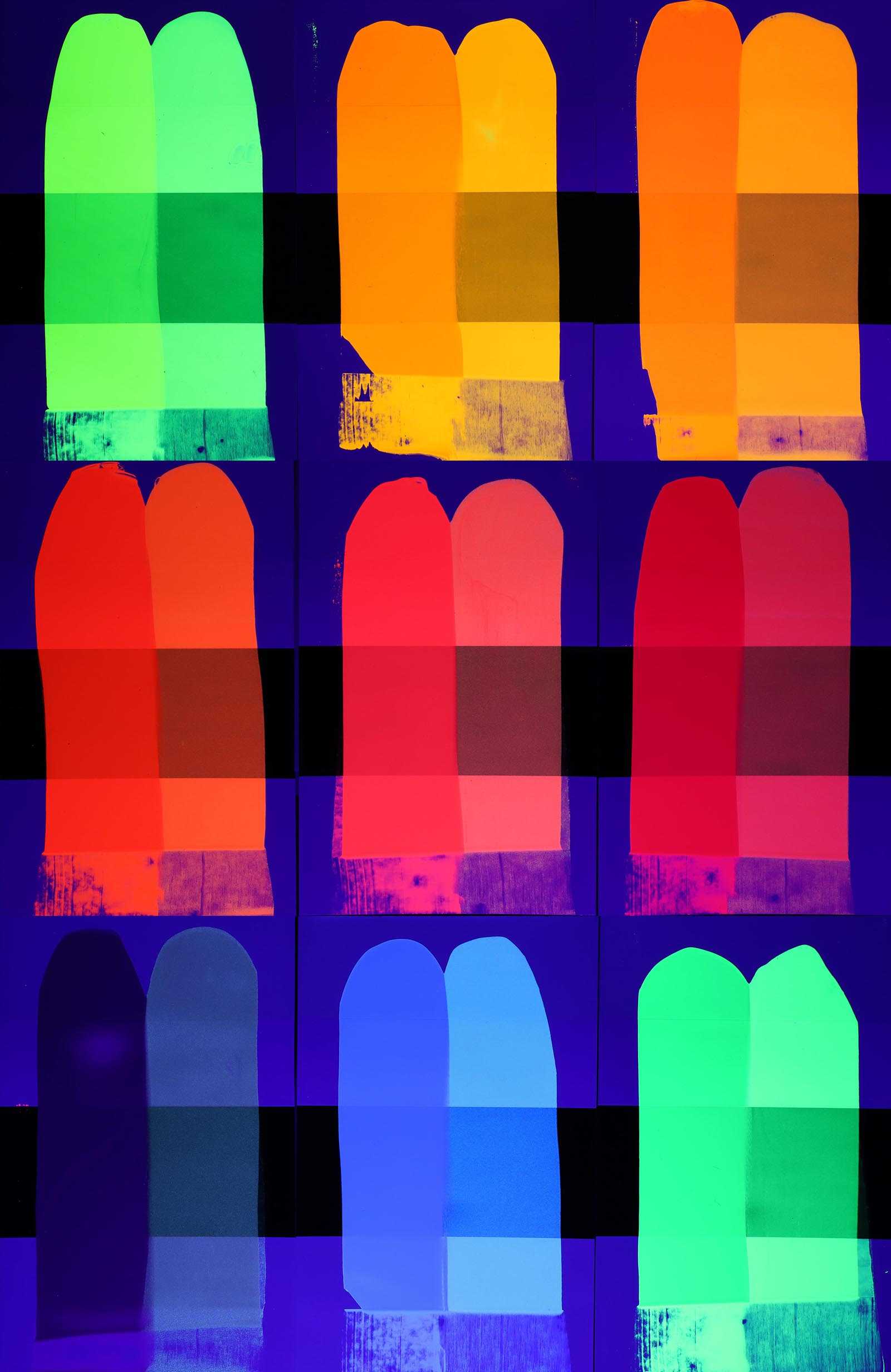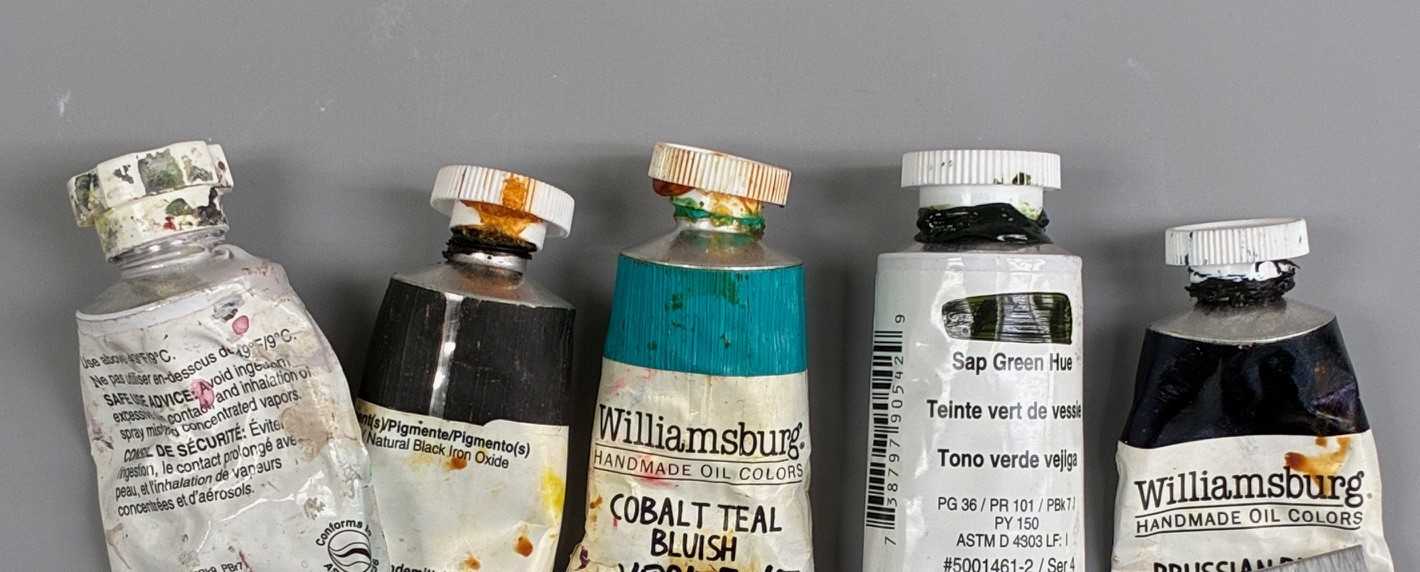NEUTRAL GRAYS
PRODUCT DESCRIPTION
GOLDEN Neutral Grays are balanced "steps" in value.

GOLDEN Neutral Grays allow the artist to adjust the value1 and chroma2 of any color without altering its hue3. GOLDEN Neutral Grays range from N2 (darkest) to N8 (lightest), with GOLDEN Bone Black as N1 and Titanium White as N10 (see figure 1). Together they produce balanced value "steps" for mixing with other colors. GOLDEN Neutral Grays can be blended with all GOLDEN Acrylics to achieve differences in color values.
NEUTRAL GRAYS ARE PART OF THE MUNSELL SYSTEM.
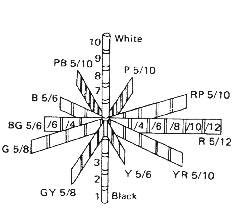
GOLDEN Neutral Grays are Heavy Body Acrylic Paints designed according to the Munsell Color System. The Munsell System divides the color wheel into a three-dimensional color-space, shaped like a distorted "egg", in which all colors are separated by their Chroma, Value, and Hue. The GOLDEN Neutral Grays are made following this system, using a spectrophotometer to ensure they have graduated steps within a very tight tolerance range. They are Achromatic, meaning that they have no distinguishable hue or chroma, only value. On the Munsell "egg", a Neutral Gray falls directly in the center, with whites on top and blacks toward the bottom.
White and black represent the two value extremes. Mixing them together will produce a gray; whether or not it is a Neutral Gray depends on the pigments used. In most cases, a true neutral will not be produced; it will likely shift towards one direction of hue and/or chroma (i.e.: warmer or cooler). GOLDEN Neutral Grays have been adjusted to stay absolutely neutral. Painting with the Neutral Grays, Bone Black and Titanium white, you create a study without chroma or hue. Use with any one color to produce a monochromatic study. Several colors mixed with the same Neutral Gray and in the same ratio will produce colors with similar value (depending on the colors' own current values).
RECOMMENDATIONS
Studies and Exercises with the Neutral Grays:
- Create a gray scale for determining values of acrylics, oils and other art media.
- Tone other colors down
- Use Neutral Grays to establish depth in a painting
- Develop a monochromatic painting
- Create value studies
- Produce neutral underpaintings for color glazes
The Munsell Notations Are Based on Opaque Readings.
Neutral Grays are formulated using opaque pigments. Generally, when mixing colors of different transparencies, the opaque colors tend to have a greater impact on the mixture than do the transparent colors. Thus, if one mixes a Neutral Gray with a transparent color with the goal of creating a certain value, the amount of Neutral Gray added must be significantly less than if working with a more opaque color. For example, Hansa Yellow Medium is dramatically more transparent than Cadmium Yellow Medium, even though both read in value around N8. It may take only a 4:1 ratio of Yellow to N4 to darken the value of Hansa Yellow Medium to N6, while Cadmium Yellow Medium will need a 2:1 ratio of Yellow to N4 to get to the value of N6.
Some experimental mixing should be done to ensure that the amount of a Neutral Gray added does not diminish all of the chroma and hue characteristics of the color blended with the Neutral Gray.
NEUTRAL GRAY VALUES OF GOLDEN HEAVY BODY ACRYLICS
This list was compiled using a spectrophotometer and independent visual assessments. The readings were based on 10mil (wet film thickness) drawdowns. Transparent colors' readings will vary with different film thicknesses. Visual assessments were viewed under GE Chroma 50 light bulbs. Other lighting environments will vary reading results. Viewing angle will also vary reading results. These readings are to the nearest Neutral Gray and are within a .50 value tolerance.
| N1 | N2 | N3 | N4 | N5 | N6 | N7 | N8 | N9 | N10 |
|---|---|---|---|---|---|---|---|---|---|
| Anthraquinone Blue | Jenkins Green | Burnt Sienna | Cerulean Blue | Cadmium Red Lt | Cadmium Orange | Diarylide Yellow | Cadmium Yellow Dk | Cadmium Yellow Lt | Titanium White |
| Bone Black | Naphthamide Maroon | Burnt Umber Lt | Chromium Oxide Green | Nickel Azo Yellow | Cobalt Teal | Cadmium Yellow Md | Cadmium Yellow Primrose | Zinc White | |
| Carbon Black | Paynes Gray | Cerulean Blue Deep | Cadmium Red Dk | Orange Oxide | Cobalt Titanate Green | Hansa Yellow Lt | Titanate Yellow | ||
| Dioxazine Purple | Permanent Violet Dk | Cobalt Blue | Cadmium Red Md | Pyrrole Orange | Yellow Oxide | Hansa Yellow Md | |||
| Mars Black | Phthalo Green YS | Cobalt Green | Cobalt Turquois | Vat Orange | Hansa Yellow Opaque | ||||
| Phthalo Blue GS | Quinacridone Burnt Orange | Graphite Gray | Green Gold | Yellow Ochre | Titan-Buff | ||||
| Phthalo Blue RS | Quinacridone Crimson | Quinacridone Gold | Mars Yellow | Primary Yellow | |||||
| Phthalo Green BS | Quinacridone Magenta | Quinacridone Red | Naphthol Red Lt | ||||||
| Turquois (Phth.) | Quinacridone Violet | Red Oxide | Naphthol Red Md | ||||||
| Raw Umber | Violet Oxide | Permanent Green Lt | |||||||
| Trans.Red Iron Oxide | Viridian Green | Pyrrole Red | |||||||
| Ultramarine Blue | Primary Cyan | Pyrrole Red Lt | |||||||
| Ultramarine Violet | Quinacridone Red Lt | ||||||||
| Raw Sienna | |||||||||
| Trans.Yellow Iron Oxide | |||||||||
| Primary Magenta |
PRODUCT PROPERTIES
The Neutral Grays are Heavy Body Golden Acrylics.
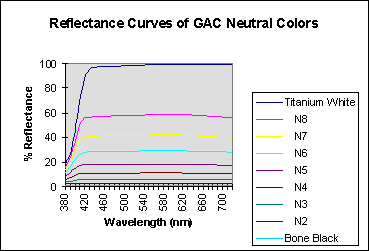
The Neutral Grays are part of Golden"s Line of Heavy Body Acrylics. The Heavy Body line is produced with 100% Acrylic Polymer Emulsion, producing a flexible paint film with excellent chemical, water and ultraviolet resistance. All pigments used in GOLDEN Acrylics are chosen for their exceptional clarity and permanency within each chemical class. GOLDEN Acrylics dry quickly and may be painted over immediately, yet complete drying will take longer.
To thin, use water or GOLDEN Mediums. For slower drying, use GOLDEN Retarder. Avoid freezing. Minimum film formation temperature is 48oF/9oC. Do not mix with oils. Paint on any non-oily surface. Non-absorbent surfaces should be abraded for increased adhesion. Clean tools with soap and water. Keep tools wet during use.
TECHNICAL INFORMATION
Resin: methylmethacrylate/butylacrylate copolymer dispersion polymer
Vehicle: water
Pigment Identification: PW6, PBk9, PBr7
Lightfastness: I (per ASTM D5298)
Permanency: Excellent
Opacity: 2 (1 = most opaque and 8 = most transparent)
Viscosity: 24,000 - 28,000 cPs (as measured on a Brookfield RV viscometer)
pH: 8.4 - 9.0 (slightly alkaline)
Gloss: 35 - 45 (using a 75o Glossmeter)
Flexibility: ASTM D522, Test Method B - Cylindrical Mandrel Test at 70oF, 6mil thick film passes at 1/4" diameter mandrel. Adequate flexibility to withstand loose rolling and restretching at room temperature. Paint films become more brittle below 50oF, and should not be bent or flexed under such conditions. Withstands expansion and contraction caused by changes in temperature and humidity.
Drying/Curing Time: a 10mil wet film will dry to touch within 2 hours when temperature is above 65oF and humidity is below 70%. Thicker films will cure much more slowly. Lower temperatures and/or higher humidities will also slow drying process considerably.
FURTHER READING
For more in-depth information about color theory, refer to publications such as the ones mentioned below. These can be found in most art stores and libraries.
The Munsell Book of Color. 1976. Munsell Color Corporation.
A Manual of Painting Materials and Techniques. 1987 Mark David Gottsegen. Wats on-Guptill Publications.
Color Right From the Start. 1994. Hilary Page. Watson-Guptill Publications.
Color Structure and Design. 1980.
Richard G. Ellinger. Van Nostrand Reinhold Company
GOLDEN Acrylics Color Mixing Guide. 1995 Golden Artist Colors, Inc.
GOLDEN Artists Colors Product Descriptions. 1995. Golden Artist Colors, Inc.
DEFINITIONS
1Value - The respective lightness or darkness of a given color. For example, Neutral Gray 7 is higher in value than Neutral Gray 6.
2Chroma - The degree of brightness of a given color. For example, Hansa Yellow Light has a high chroma.
3Hue - Refers to the primary or secondary color associated with a given color. For example, Pyrrole Red Light has a yellow hue when compared to Pyrrole Red, which has a bluer hue.
Disclaimer
The above information is based on research and testing done by Golden Artist Colors, Inc., and is provided as a basis for understanding the potential uses of the products mentioned. Due to the numerous variables in methods, materials and conditions of producing art, Golden Artist Colors, Inc. cannot be sure the product will be right for you. Therefore, we urge product users to test each application to ensure all individual project requirements are met. While we believe the above information is accurate, WE MAKE NO EXPRESS OR IMPLIED WARRANTIES OF MERCHANTABILITY OR FITNESS FOR A PARTICULAR PURPOSE, and we shall in no event be liable for any damages (indirect, consequential, or otherwise) that may occur as a result of a product application.

